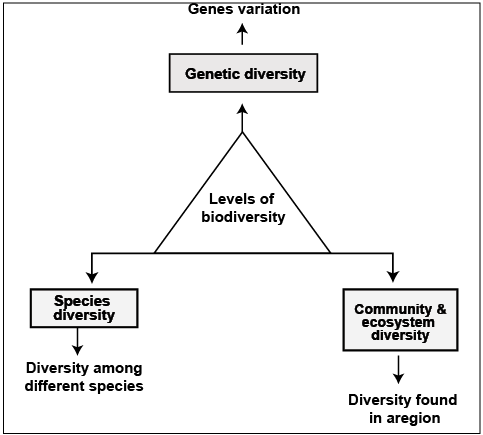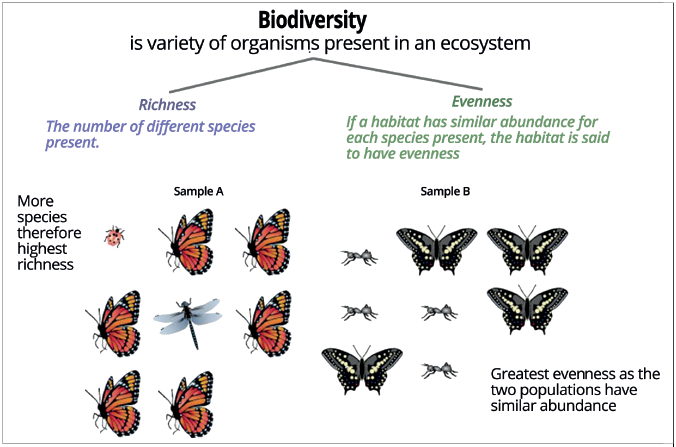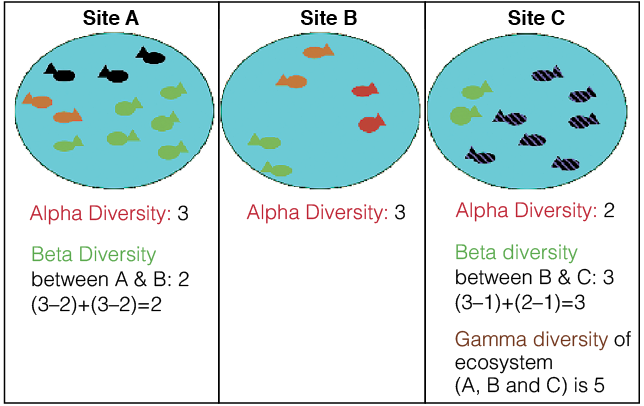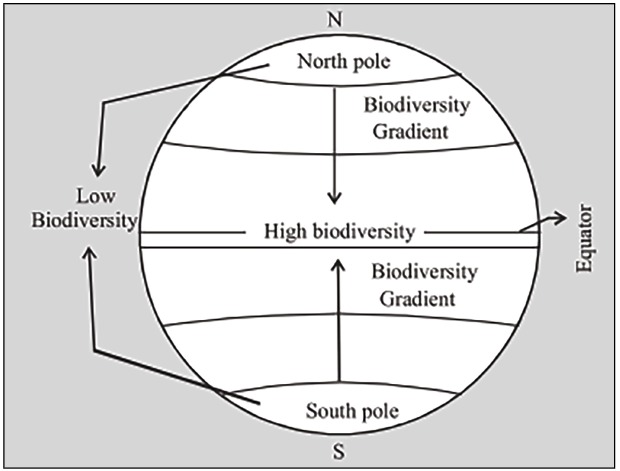
Biodiversity or Biological Diversity is fundamental to the health and stability of ecosystems. Understanding it is crucial for managing and protecting the environment. This article aims to study in detail the concept of Biodiversity or Biological Diversity, its meaning, types, levels, measures, sources, causes of loss, conservation measures, and other related concepts.
What is Biodiversity?
- Biodiversity is the short form of Biological Diversity.
- It refers to the variety of all living things, including different animals, plants, and microorganisms, the genetic information they contain and the ecosystems they form.
- It forms the web of life, of which we are an integral part and upon which we depend almost entirely.
Levels of Biodiversity
- Three levels of biological diversity are generally accepted: genetic, species, and ecosystem.
- These levels are interconnected, yet distinct enough to be studied as three separate components.

Genetic Diversity
- Genetic diversity is the variety of genes within a species.
- Genetic diversity can be measured at various levels, such as population, species, community, and biome. E.g. Due to habitat fragmentation genetic diversity of Indian tigers has been reduced.
- Genetic diversity is important as it serves as foundation for evolution and adaptation.
- Greater genetic diversity within a species or population enhances the ability of some individuals to adapt to environmental changes.
- Lesser genetic diversity results in uniformity, which poses a long-term problem, as it’s unlikely that any individual within the population could adapt to changing conditions.
Species Diversity
- Species diversity refers to the variety of species found within a habitat or a region.
- Some habitats, such as rainforests and coral reefs, have high species diversity.
- For Example, a good climate with good physical geography supports better species diversity.
- There are two levels of species diversity:
- Regional Diversity of whole nations or parts of continents within which many different communities exist
- Local Diversity in a given nation where different communities exist at different latitudes.
- The two main components of Species Diversity include – Faunal Diversity and Floral Diversity.
Ecosystem Diversity
- Ecosystem diversity is the variety of ecosystems at a given place.
- It incorporates both habitat and community diversity.
- Ecosystem diversity encompasses both biotic (living) and abiotic (non-living) elements, distinguishing it from genetic and species diversity.
- As the environment changes, the species best adapt to itself according to the environment thus the diversity of the species in an ecosystem is influenced by the ecosystem itself.
- Invertebrates (i.e. animals without backbones) comprise around 99% of all animal species, and most of them are insects.
- Invertebrates encompass a range of animals including crabs, snails, worms, corals, seastars, and insects like beetles and flies.
- Insects play crucial roles in ecosystems by acting as pollinators, nutrient recyclers, scavengers, and a food source for other organisms.
Measurement of Biodiversity
The Biological Diversity is defined and measured through two components — richness and evenness.

Richness
- Richness is refers to the number of species.
- Thus, it is usually called Species Richness.
- Here individuals are genetically or functionally related.
Evenness
- Evenness is proportions of species or functional groups present on a site.
- The more equal species are in proportion to each other, the greater is the evenness of the site.
- A site with low evenness indicates that a few species dominate the site.
- Species diversity is a measure that combines both species richness and species evenness.
- It is a measurement of species richness combined with evenness.
- Thus, it takes into account not only the number of species present, but also how evenly the numbers of each species are distributed.
Spatial Components of Biological Diversity
R H Whittaker classified the spatial component of biological diversity into alpha, beta, and gamma diversity.
Alpha Diversity
Alpha diversity refers to the diversity within a specific area or ecosystem, typically measured by the number of species (species richness) present in that ecosystem.
Beta Diversity
- Beta Diversity refers to the change in species diversity between two ecosystems.
- For example, measuring species diversity between the grassland and terrain ecosystem.
Gamma Diversity
- Gamma diversity measures the overall diversity across different ecosystems within a region.
- Gamma diversity can also be defined as “geographic-scale species diversity.

Patterns of Biodiversity
Broadly, there are two kinds of biological diversity patterns – Latitudinal Diversity Gradient and Species-Area Relationship.
Latitudinal Diversity Gradient
- According to the Latitudinal Diversity Gradient (LDG), the species diversity follows a regular pattern as we move from the equator to the polar regions.
- The plant and animal diversity is the maximum at the equator and decreases as we move towards the poles.
- This increase in species richness is called the Latitudinal Diversity Gradient.

Species-Area Relationship
- The Species-Area Relationship describes the general trend and pattern of increase in species richness with increasing area of observation.
- Usually, the larger areas contain more species than smaller areas.
Sources of Biological Diversity
Mutation
- Mutations increase genetic diversity by altering the genetic material (mostly DNA) of organisms.
- It is an extremely slow process compared to the other ways in which local diversity increases.
Speciation
- The creation of a new species is known as speciation.
- It occurs when groups in a species become reproductively isolated and diverge.
- Speciation can occur through several different means, such as natural selection, competition, mutation, etc.
Read our detailed article on Speciation.
Immigration
- Immigration increases diversity as new individuals and perhaps even new species enter an area, increasing its diversity.
- The rate at which immigration happens depends on the size of the area in question, how many species are there already, and how close the area in question is to the source of immigration.
Succession
- Succession is the process through which an area gains species as successive communities of organisms replace one another until an end-point is reached.
Biodiversity Loss
- It refers to the decline or disappearance of biological diversity within a species, ecosystem, geographic area, or on the entire planet.
- It’s essentially a reduction in the variety of life on Earth.
Read our detailed article on Biodiversity Loss.
Biodiversity Conservation
- It means the protection, preservation, management, and restoration of natural environments and their ecological processes.
- It involves safeguarding the variety of life forms on Earth, including plants, animals, microorganisms, and their ecosystems.
Read our detailed article on Conservation of Biological Diversity.
Conclusion
Biodiversity is a cornerstone of environmental health and human well-being. By understanding the importance of biological diversity, recognizing the threats it faces, and implementing effective conservation measures, we can ensure a sustainable future for both the natural world and human society. Concerted efforts from individuals, communities, governments, and international organisations are required for the same.
Simposn’s Diversity Index
- Simposn’s diversity index is often used to quantify the biological diversity of a habitat.
- According to this index, zero represents infinite diversity, whereas one represents only one species dominating the landscape and no diversity.
FAQs
Why is biodiversity important?
Biological diversity is crucial for the health and well-being of our planet and all the living beings because of the ecosystem services, resources and economic benefits they provide.
Who coined the term biodiversity?
The term “biodiversity” was coined by the American biologist Edward O. Wilson.
What are the advantages of biodiversity?
Biological diversity ensures the health of our ecosystem and also provides resouces which are of economic benefits.
Who is the father of biodiversity?
The title “father of biodiversity” is attributed to Norman Myers, a British biologist and environmentalist.
Why is biodiversity important for human lives?
It is important for human lives because of the ecosystem services, and food and other resources they provide.






